tow TOYOTA AVALON 2021 Owners Manual (in English)
[x] Cancel search | Manufacturer: TOYOTA, Model Year: 2021, Model line: AVALON, Model: TOYOTA AVALON 2021Pages: 548, PDF Size: 13.4 MB
Page 3 of 548

3
1
8 7 5 4
3
2
9
6
3-1. Key information
Keys .................................. 122
3-2. Opening, closing and
locking the doors
Doors................................. 125
Trunk ................................. 131
Smart key system.............. 135
3-3. Adjusting the seats
Front seats ........................ 142
Rear seats ......................... 144
Driving position
memory ........................... 146
Head restraints .................. 151
3-4. Adjusting the steering
wheel and mirrors
Steering wheel .................. 153
Inside rear view mirror....... 155
Outside rear view
mirrors ............................. 157
3-5. Opening and closing
the windows
Power windows ................. 160
Moon roof .......................... 1644-1. Before driving
Driving the vehicle ............. 170
Cargo and luggage ............ 178
Vehicle load limits .............. 181
Trailer towing ..................... 182
Dinghy towing .................... 183
4-2. Driving procedures
Engine (ignition) switch...... 184
Automatic transmission ..... 189
Turn signal lever ................ 195
Parking brake .................... 196
Brake Hold ......................... 200
4-3. Operating the lights
and wipers
Headlight switch ................ 202
Automatic High Beam ........ 206
Windshield wipers
and washer ...................... 210
4-4. Refueling
Opening the fuel tank
cap................................... 214
3Operation of each
component4Driving
Page 5 of 548

5
1
8 7 5 4
3
2
9
6
6-1. Maintenance and care
Cleaning and protecting
the vehicle exterior .......... 366
Cleaning and protecting
the vehicle interior ........... 369
6-2. Maintenance
Maintenance
requirements ................... 372
General maintenance ........ 374
Emission inspection and
maintenance (I/M)
programs ......................... 378
6-3. Do-it-yourself
maintenance
Do-it-yourself service
precautions ..................... 379
Hood.................................. 381
Positioning a floor jack ...... 382
Engine compartment ......... 383
Tires .................................. 394
Tire inflation pressure........ 408
Wheels .............................. 411
Air conditioning filter .......... 413
Electronic key battery ........ 415
Checking and replacing
fuses ............................... 418
Light bulbs ......................... 4217-1. Essential information
Emergency flashers ........... 424
If your vehicle has to be
stopped in an
emergency....................... 425
If the vehicle is trapped
in rising water .................. 426
7-2. Steps to take in
an emergency
If your vehicle needs to
be towed .......................... 427
If you think something
is wrong ........................... 432
Fuel pump shut off
system ............................. 433
If a warning light turns on
or a warning buzzer
sounds ............................. 434
If a warning message is
displayed ......................... 444
If you have a flat tire .......... 449
If the engine will
not start ........................... 461
If the electronic key does
not operate properly ........ 463
If the vehicle battery is
discharged ....................... 466
If your vehicle overheats.... 471
If the vehicle becomes
stuck ................................ 474
6Maintenance and care7When trouble arises
Page 18 of 548
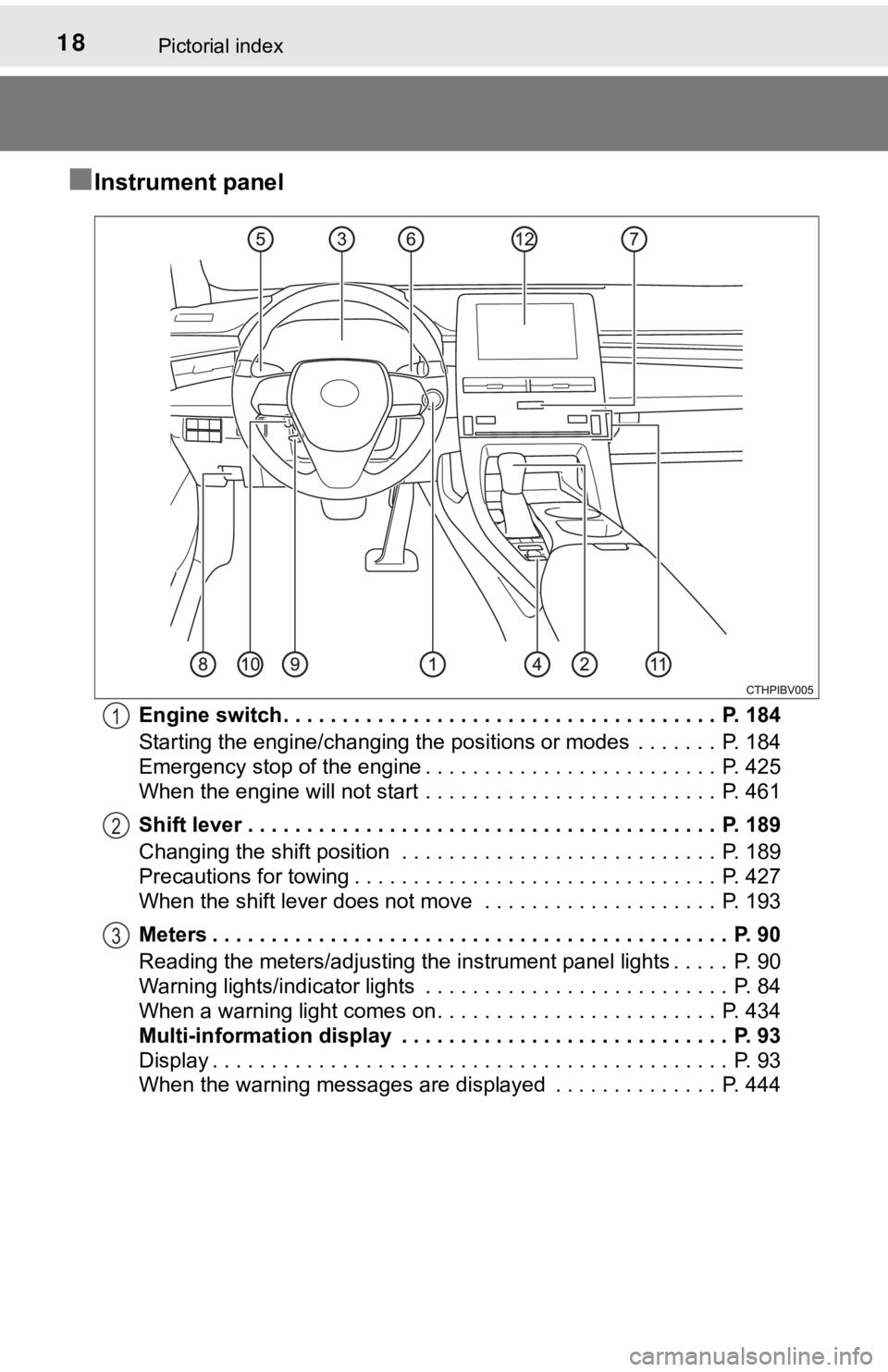
18Pictorial index
■Instrument panel
Engine switch . . . . . . . . . . . . . . . . . . . . . . . . . . . . . . . . . . . . . P. 184
Starting the engine/changing the positions or modes . . . . . . . P. 184
Emergency stop of the engine . . . . . . . . . . . . . . . . . . . . . . . . . P. 425
When the engine will not start . . . . . . . . . . . . . . . . . . . . . . . . . P. 461
Shift lever . . . . . . . . . . . . . . . . . . . . . . . . . . . . . . . . . . . . . . . . P. 189
Changing the shift position . . . . . . . . . . . . . . . . . . . . . . . . . . . P. 189
Precautions for towing . . . . . . . . . . . . . . . . . . . . . . . . . . . . . . . P. 427
When the shift lever does not move . . . . . . . . . . . . . . . . . . . . P. 193
Meters . . . . . . . . . . . . . . . . . . . . . . . . . . . . . . . . . . . . . . . . . . . . P. 90
Reading the meters/adjusting the instrument panel lights . . . . . P. 90
Warning lights/indicator lights . . . . . . . . . . . . . . . . . . . . . . . . . . P. 84
When a warning light comes on . . . . . . . . . . . . . . . . . . . . . . . . P. 434
Multi-information display . . . . . . . . . . . . . . . . . . . . . . . . . . . . P. 93
Display . . . . . . . . . . . . . . . . . . . . . . . . . . . . . . . . . . . . . . . . . . . . P. 93
When the warning messages are displayed . . . . . . . . . . . . . . P. 4441
2
3
Page 39 of 548

391-1. For safe use
1
For safety and security
WARNING
■SRS airbag precautions
Observe the following precautions regarding the SRS airbags.
Failure to do so may cause death or serious injury.
●The driver and all passengers in the vehicle must wear their seat belts
properly.
The SRS airbags are supplemental devices to be used with the seat belts.
●The SRS driver airbag deploys with considerable force, and can cause
death or serious injury especially if the driver is very close to the airbag.
The National Highway Traffic Safety Administration (NHTSA) advises:
Since the risk zone for the driver’s airbag is the first 2 - 3 in. (50 - 75 mm)
of inflation, placing yourself 10 in. (250 mm) from your driver airbag pro-
vides you with a clear margin of safety. This distance is measured from
the center of the steering wheel to your breastbone. If you sit less than 10
in. (250 mm) away now, you can change your driving position in several
ways:
• Move your seat to the rear as far as you can while still reaching the ped-
als comfortably.
• Slightly recline the back of the seat.
Although vehicle designs vary, many drivers can achieve the 10 in. (250
mm) distance, even with the driver seat all the way forward, simply by
reclining the back of the seat somewhat. If reclining the back of your
seat makes it hard to see the road, raise yourself by using a firm, non-
<0056004f004c0053005300480055005c0003004600580056004b004c00520051000f000300520055000300550044004c0056004800030057004b0048000300560048004400570003004c00490003005c005200580055000300590048004b004c0046004f00
480003004b0044005600030057004b00440057000300490048[ature.
• If your steering wheel is adjustable, tilt it downward. This points the air-
bag toward your chest instead of your head and neck.
The seat should be adjusted as recommended by NHTSA above, while
still maintaining control of the foot pedals, steering wheel, and your view
of the instrument panel controls.
Page 41 of 548
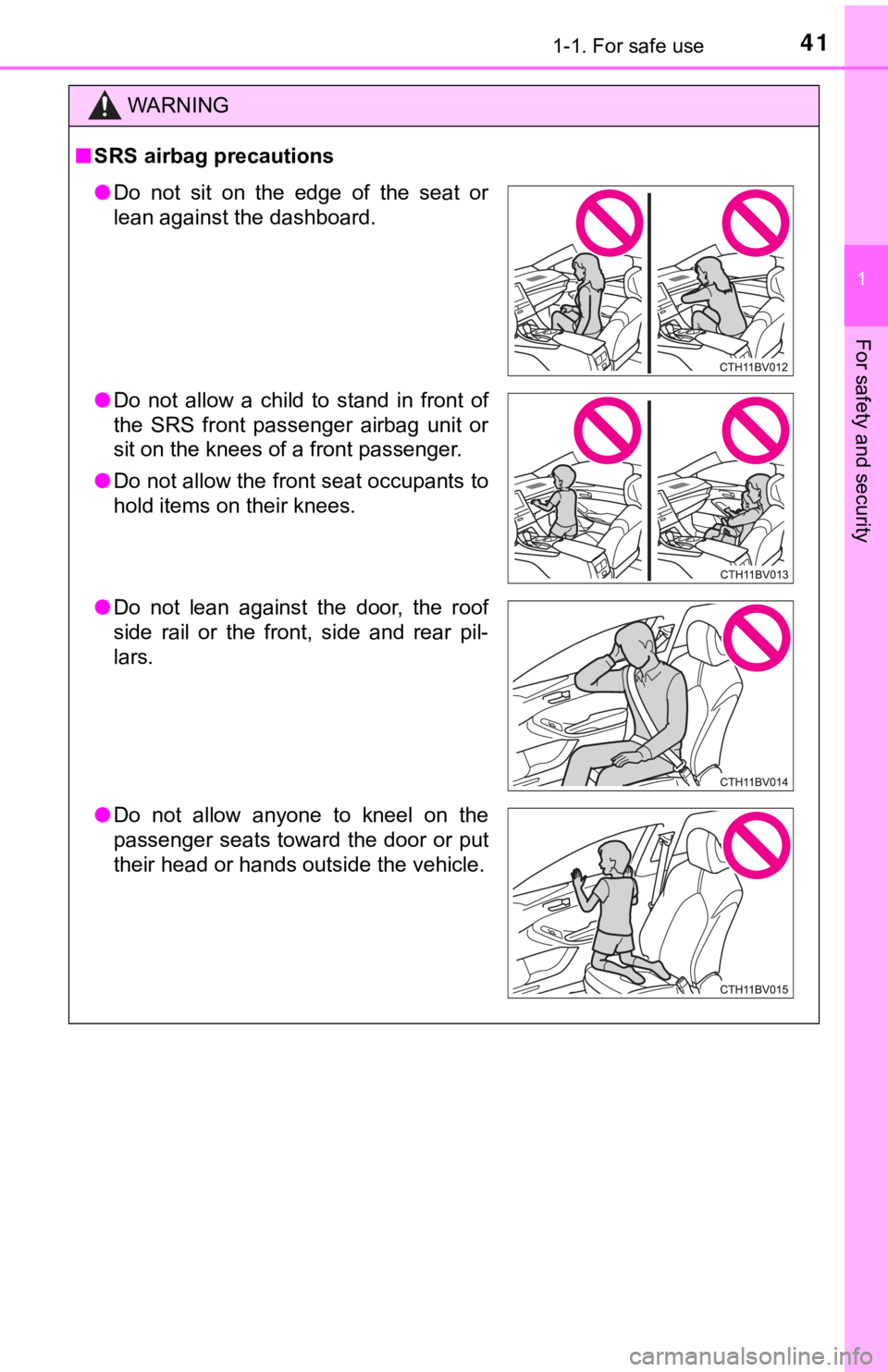
411-1. For safe use
1
For safety and security
WARNING
■SRS airbag precautions
●Do not sit on the edge of the seat or
lean against the dashboard.
●Do not allow a child to stand in front of
the SRS front passenger airbag unit or
sit on the knees of a front passenger.
●Do not allow the front seat occupants to
hold items on their knees.
●Do not lean against the door, the roof
side rail or the front, side and rear pil-
lars.
●Do not allow anyone to kneel on the
passenger seats toward the door or put
their head or hands outside the vehicle.
Page 75 of 548
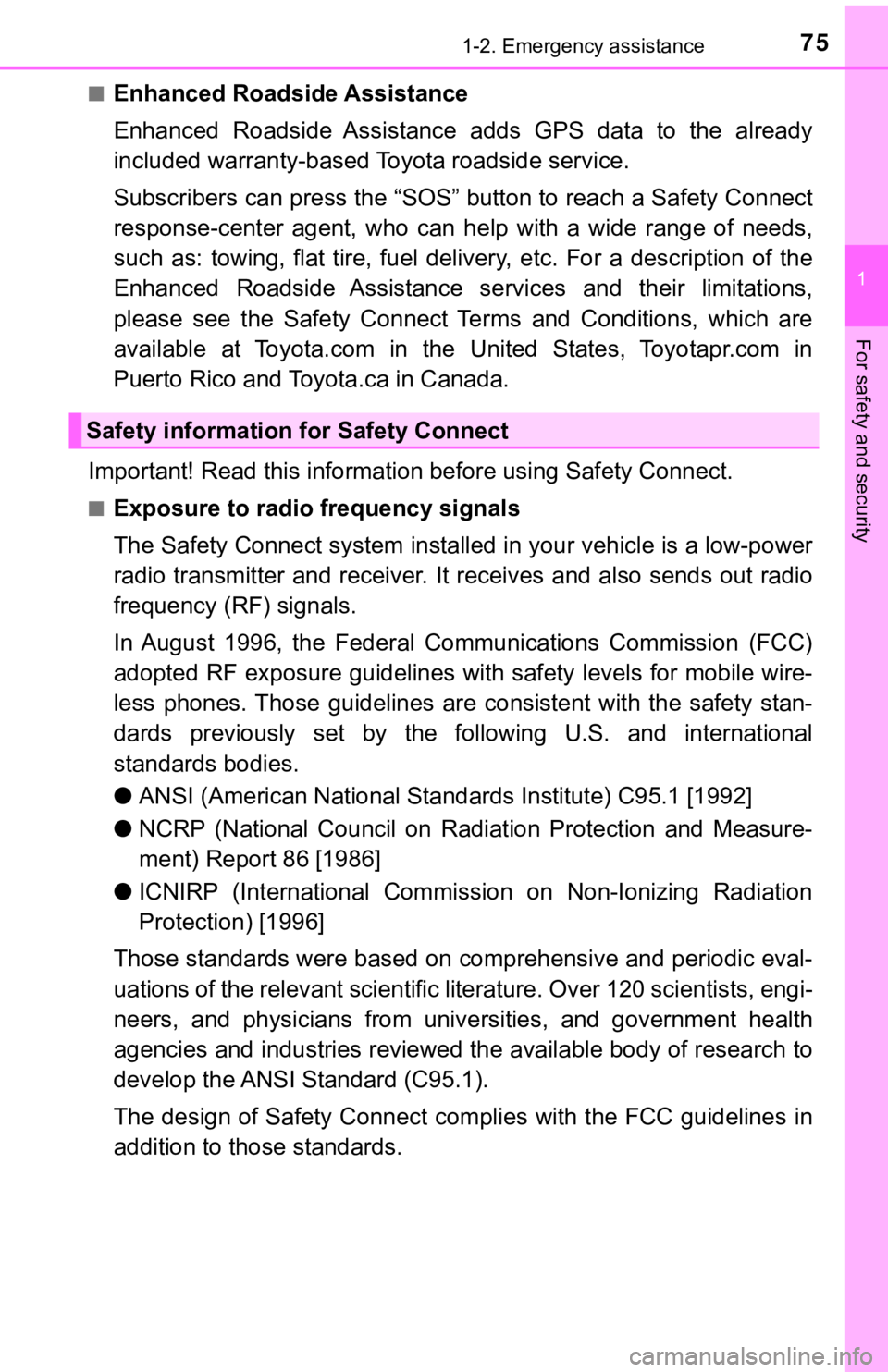
751-2. Emergency assistance
1
For safety and security
■Enhanced Roadside Assistance
Enhanced Roadside Assistance adds GPS data to the already
included warranty-based Toyota roadside service.
Subscribers can press the “SOS” button to reach a Safety Connect
response-center agent, who can help with a wide range of needs,
such as: towing, flat tire, fuel delivery, etc. For a description of the
Enhanced Roadside Assistance services and their limitations,
please see the Safety Connect Terms and Conditions, which are
available at Toyota.com in the United States, Toyotapr.com in
Puerto Rico and Toyota.ca in Canada.
Important! Read this information before using Safety Connect.
■Exposure to radio frequency signals
The Safety Connect system installed in your vehicle is a low-power
radio transmitter and receiver. It receives and also sends out radio
frequency (RF) signals.
In August 1996, the Federal Communications Commission (FCC)
adopted RF exposure guidelines with safety levels for mobile wire-
less phones. Those guidelines are consistent with the safety stan-
dards previously set by the following U.S. and international
standards bodies.
●ANSI (American National Standards Institute) C95.1 [1992]
●NCRP (National Council on Radiation Protection and Measure-
ment) Report 86 [1986]
●ICNIRP (International Commission on Non-Ionizing Radiation
Protection) [1996]
Those standards were based on comprehensive and periodic eval-
uations of the relevant scientific literature. Over 120 scientists, engi-
neers, and physicians from universities, and government health
agencies and industries reviewed the available body of research to
develop the ANSI Standard (C95.1).
The design of Safety Connect complies with the FCC guidelines in
addition to those standards.
Safety information for Safety Connect
Page 137 of 548
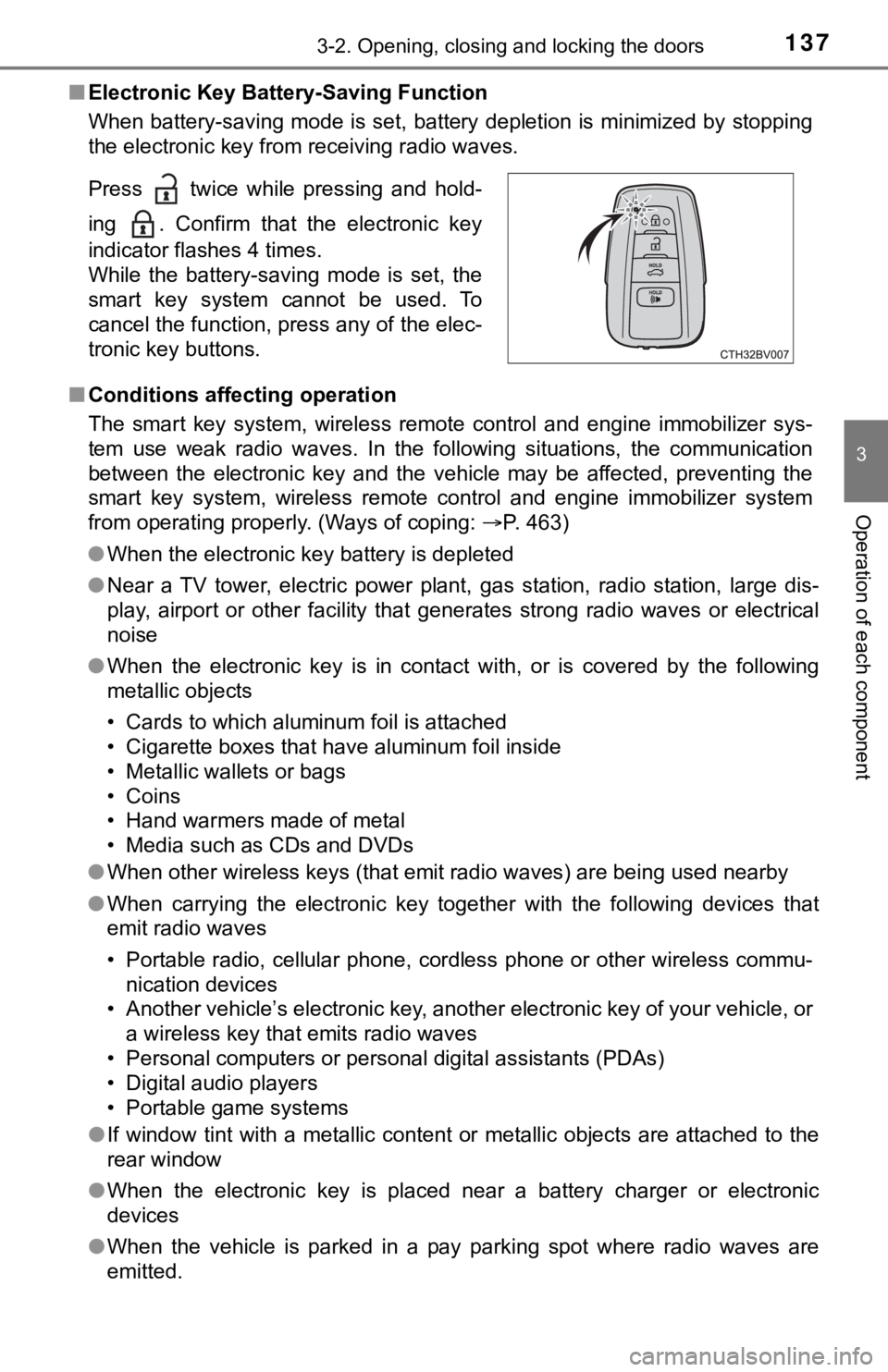
1373-2. Opening, closing and locking the doors
3
Operation of each component
■Electronic Key Battery-Saving Function
When battery-saving mode is set, battery depletion is minimized by stopping
the electronic key from receiving radio waves.
■Conditions affecting operation
The smart key system, wireless remote control and engine immobilizer sys-
tem use weak radio waves. In the following situations, the communication
between the electronic key and the vehicle may be affected, preventing the
smart key system, wireless remote control and engine immobilizer system
from operating properly. (Ways of coping: P. 463)
●When the electronic key battery is depleted
●Near a TV tower, electric power plant, gas station, radio station, large dis-
play, airport or other facility that generates strong radio waves or electrical
noise
●When the electronic key is in contact with, or is covered by the following
metallic objects
• Cards to which aluminum foil is attached
• Cigarette boxes that have aluminum foil inside
• Metallic wallets or bags
• Coins
• Hand warmers made of metal
• Media such as CDs and DVDs
●When other wireless keys (that emit radio waves) are being used nearby
●When carrying the electronic key together with the following devices that
emit radio waves
• Portable radio, cellular phone, cordless phone or other wireless commu-
nication devices
• Another vehicle’s electronic key, another electronic key of your vehicle, or
a wireless key that emits radio waves
• Personal computers or personal digital assistants (PDAs)
• Digital audio players
• Portable game systems
●If window tint with a metallic content or metallic objects are attached to the
rear window
●When the electronic key is placed near a battery charger or electronic
devices
●When the vehicle is parked in a pay parking spot where radio waves are
emitted. Press twice while pressing and hold-
ing . Confirm that the electronic key
indicator flashes 4 times.
While the battery-saving mode is set, the
smart key system cannot be used. To
cancel the function, press any of the elec-
tronic key buttons.
Page 153 of 548
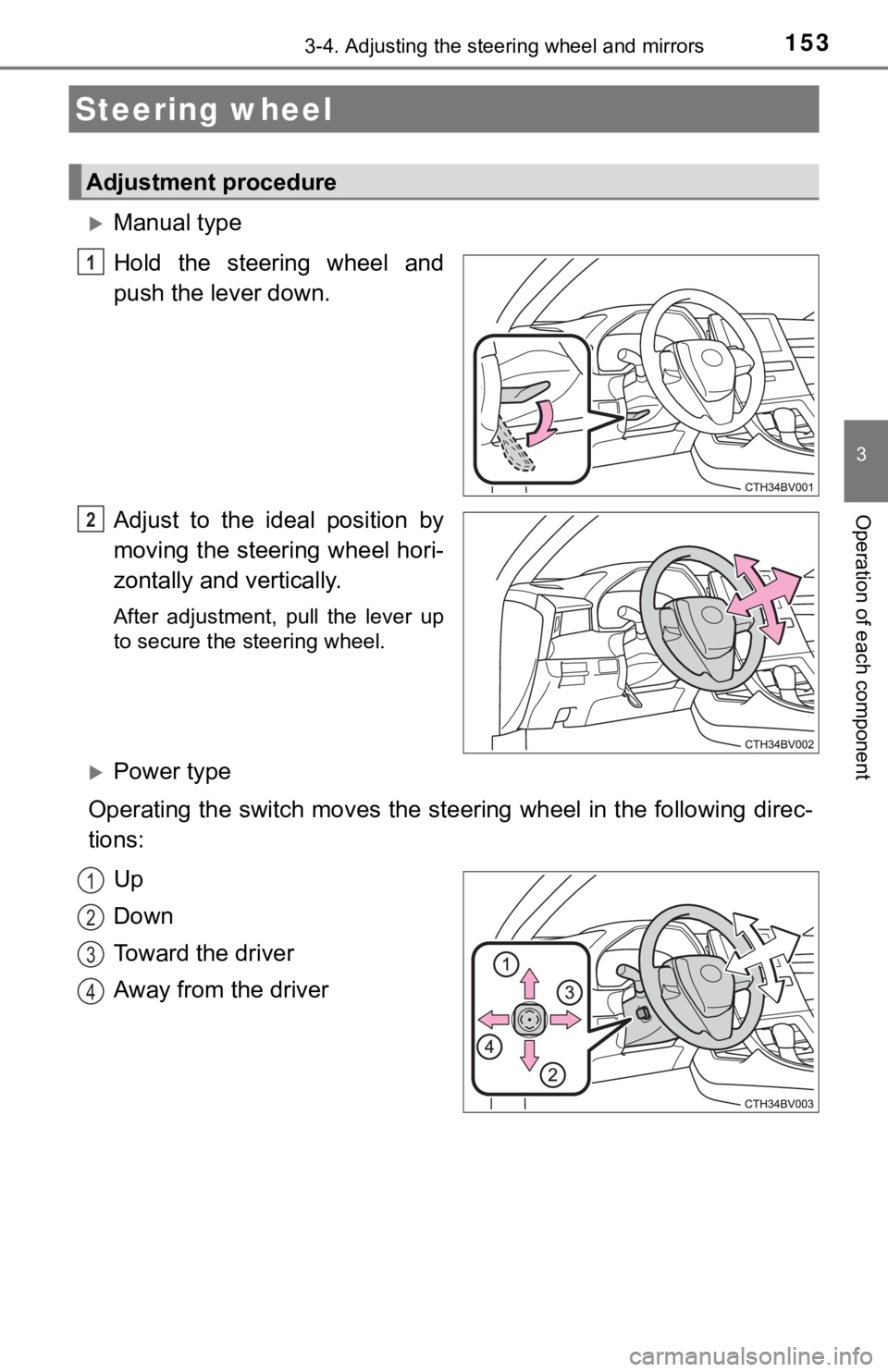
153
3
Operation of each component
3-4. Adjusting the steering wheel and mirrors
Manual type
Hold the steering wheel and
push the lever down.
Adjust to the ideal position by
moving the steering wheel hori-
zontally and vertically.
After adjustment, pull the lever up
to secure the steering wheel.
Power type
Operating the switch moves the steering wheel in the following direc-
tions:
Up
Down
Toward the driver
Away from the driver
Steering wheel
Adjustment procedure
1
2
1
2
3
4
Page 169 of 548

169
4Driving
4-1. Before driving
Driving the vehicle ............. 170
Cargo and luggage ........... 178
Vehicle load limits ............. 181
Trailer towing..................... 182
Dinghy towing ................... 183
4-2. Driving procedures
Engine (ignition) switch ..... 184
Automatic transmission ..... 189
Turn signal lever................ 195
Parking brake .................... 196
Brake Hold ........................ 200
4-3. Operating the lights
and wipers
Headlight switch ................ 202
Automatic High Beam ....... 206
Windshield wipers
and washer ..................... 210
4-4. Refueling
Opening the fuel
tank cap .......................... 2144-5. Using the driving
support systems
Toyota Safety Sense P ..... 218
PCS
(Pre-Collision System) .... 226
LDA
(Lane Departure Alert
with steering control) ....... 237
Dynamic radar cruise
controlwith full-speed
range............................... 247
BSM
(Blind Spot Monitor) ........ 260
• BSM function ................ 264
• RCTA function .............. 267
Rear Camera Detection
function (vehicles with
panoramic view
monitor)........................... 272
Intuitive parking assist....... 276
Intelligent Clearance
Sonar (ICS) ..................... 284
Driving mode select
switches .......................... 305
Driving assist systems ...... 309
4-6. Driving tips
Winter driving tips ............. 317
Page 178 of 548
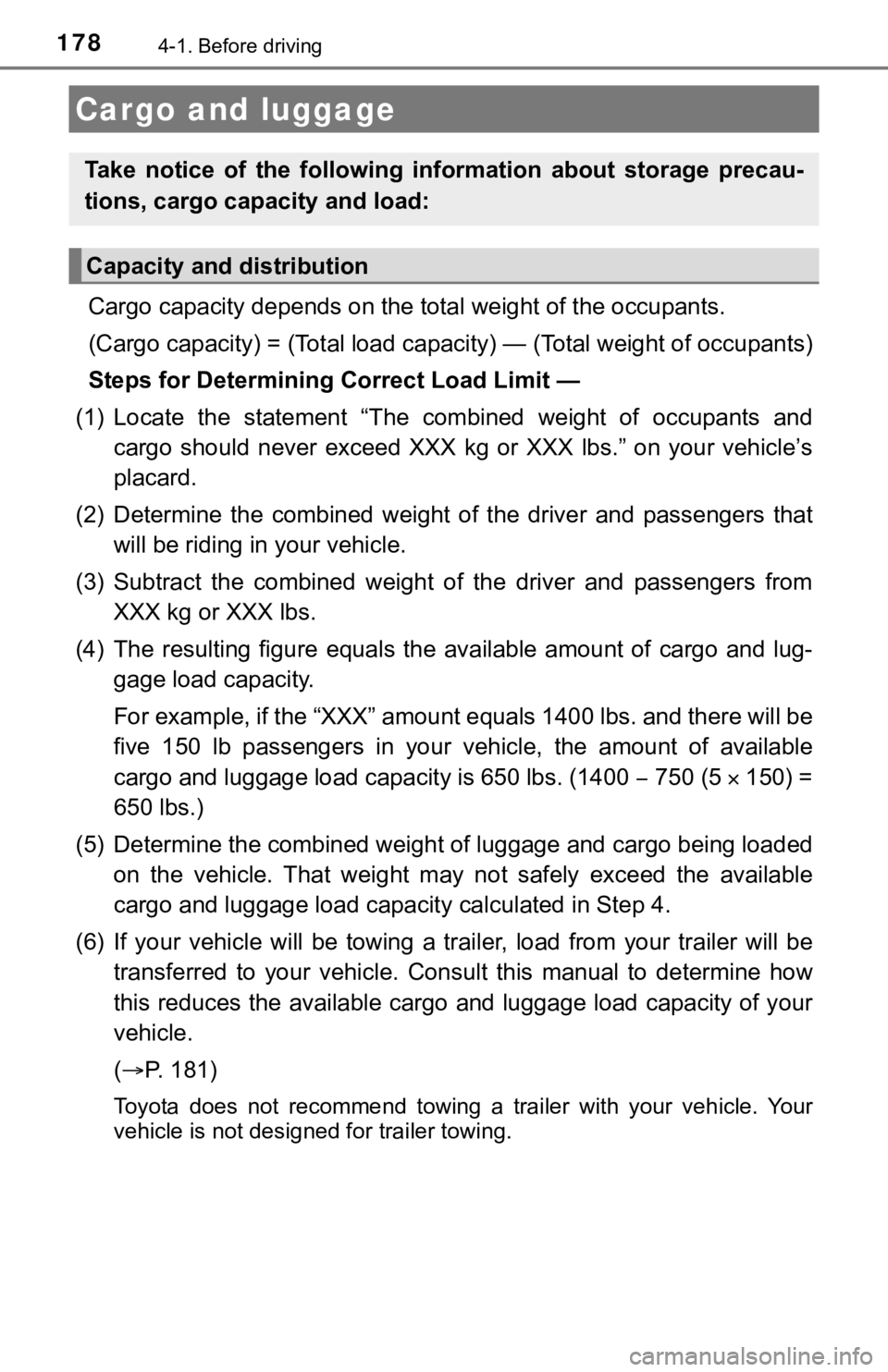
1784-1. Before driving
Cargo capacity depends on the total weight of the occupants.
(Cargo capacity) = (Total load capacity) — (Total weight of occupants)
Steps for Determining Correct Load Limit —
(1) Locate the statement “The combined weight of occupants and
cargo should never exceed XXX kg or XXX lbs.” on your vehicle’s
placard.
(2) Determine the combined weight of the driver and passengers that
will be riding in your vehicle.
(3) Subtract the combined weight of the driver and passengers from
XXX kg or XXX lbs.
(4) The resulting figure equals the available amount of cargo and lug-
gage load capacity.
For example, if the “XXX” amount equals 1400 lbs. and there will be
five 150 lb passengers in your vehicle, the amount of available
cargo and luggage load capacity is 650 lbs. (1400 750 (5150) =
650 lbs.)
(5) Determine the combined weight of luggage and cargo being loaded
on the vehicle. That weight may not safely exceed the available
cargo and luggage load capacity calculated in Step 4.
(6) If your vehicle will be towing a trailer, load from your trailer will be
transferred to your vehicle. Consult this manual to determine how
this reduces the available cargo and luggage load capacity of your
vehicle.
(P. 181)
Toyota does not recommend towing a trailer with your vehicle. Your
vehicle is not designed for trailer towing.
Cargo and luggage
Take notice of the following information about storage precau-
tions, cargo capacity and load:
Capacity and distribution